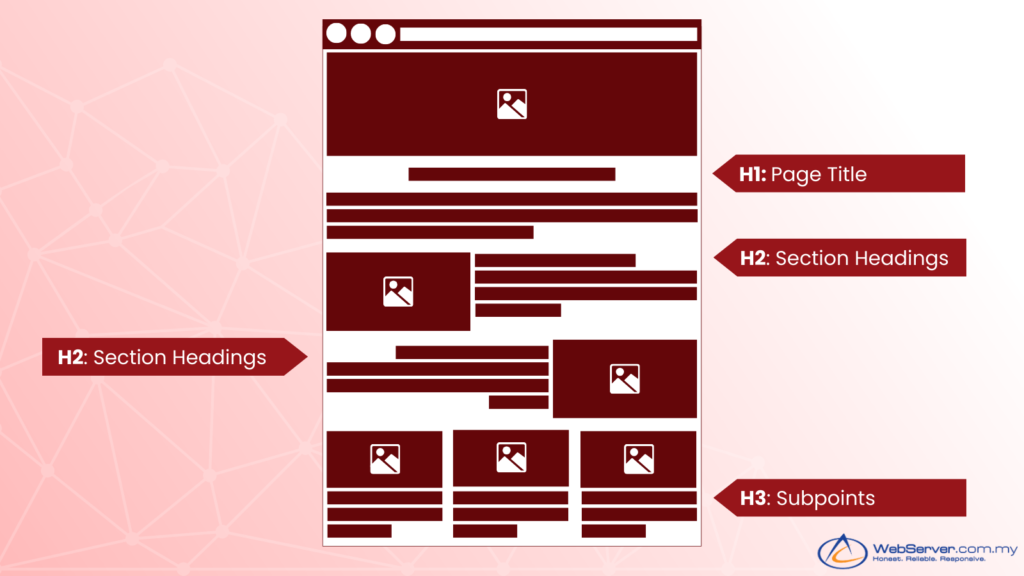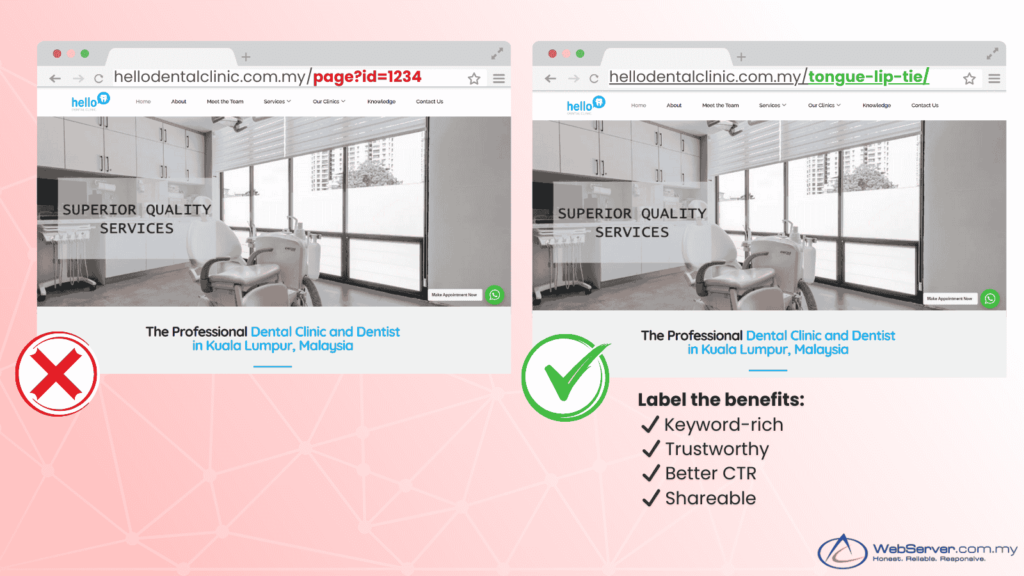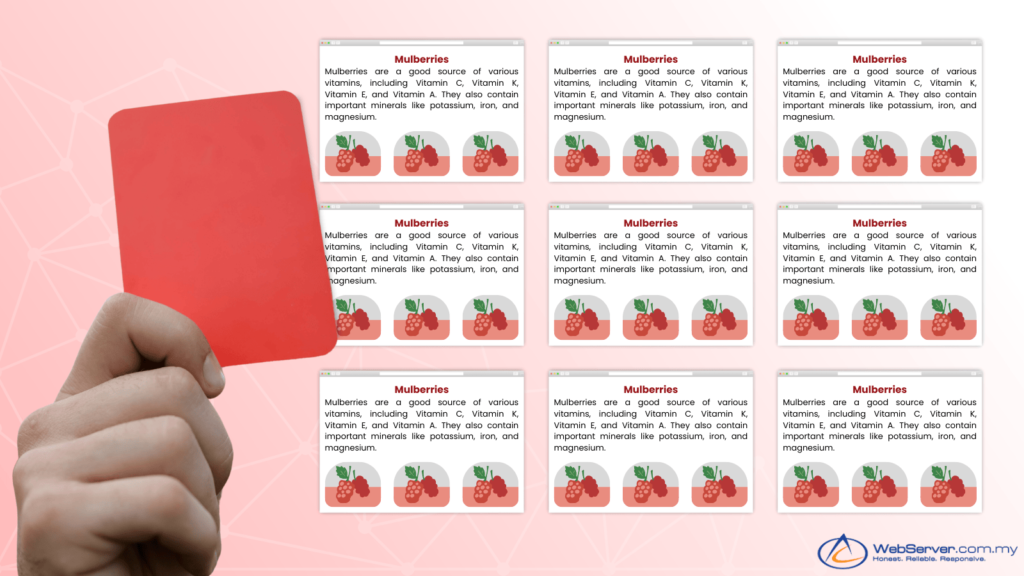-
Sales +603 2770 2833
- sales@webserver.com.my
What are the main elements of on-page SEO optimisation?
Table of Contents
ToggleIn digital marketing, Search Engine Optimisation (SEO) is essential for making your website visible. On-page SEO refers to optimizes individual web pages to improve rankings and attract relevant traffic. It includes various techniques to enhance a page’s content and HTML source code.
On-page SEO elements are crucial for boosting search engine rankings and increasing organic traffic. By optimizing title tags, meta descriptions, and header tags, you show search engines that your content is relevant, which improves visibility. Additionally, well-optimized pages enhance user experience by making your site easier to navigate, faster, and more mobile-friendly. This keeps visitors engaged, lowers bounce rates, and boosts conversion rates.
On-page SEO is essential for a strong online presence. It helps search engines find your website and offers a smooth experience for visitors.
Title Tags and Meta Descriptions
Title Tags
Title tags are HTML elements that define a web page’s title. They appear as clickable headlines on search engine results pages (SERPs) and are important for SEO, user experience, and social sharing. Title tags give a brief description of the page’s content.
Meta Descriptions
Meta descriptions are short summaries of a web page’s content that appear below the title in search results. Although they don’t directly affect search rankings, they are essential for improving click-through rates by giving users a preview of the page’s content.
Header Tags (H1, H2, H3, etc.)

Purpose of Header Tags in Structuring Content
Header tags (H1 to H6) are HTML elements that define headings and subheadings in web content. They are essential for organizing content, enhancing readability, and improving accessibility for both users and search engines.
- H1 Tag: This is the main heading of a web page and should be used only once. It represents the primary topic of the page.
- H2 Tags: These are used for main sections within the content and help to break down the information into digestible parts.
- H3, H4, H5, and H6 Tags: These are subheadings that further organize the content, creating a hierarchy that facilitates easier navigation and understanding of the information.
Importance of Using Keywords in Header Tags
Using keywords in header tags is essential for several reasons:
- Improved SEO: Including relevant keywords in your header tags helps search engines identify the primary topics of your content. This can improve your rankings for those keywords and increase your visibility on search engine results pages (SERPs).
- User Experience: Keywords in headers help users quickly determine if the content on the page matches their search intent. Clear, keyword-rich headers guide users through the content, improving their overall experience and reducing bounce rates.
- Content Relevance: When search engines see keywords in your headers, it reinforces the relevance of the content to the search queries related to those keywords. This alignment between content and search intent can boost your site’s authority and credibility.
URL Structure
Importance of a Clean and Descriptive URL Structure
A clean URL structure is crucial for SEO and user experience. It helps search engines and users quickly understand a page’s content, improving indexing and navigation. Optimized URLs can boost click-through rates and make your site easier to use.
SEO Benefits:

- Keyword Relevance: Including relevant keywords in your URLs can improve your page’s ranking potential for those terms.
- Indexing: Clear, descriptive URLs help search engines better understand your page content, leading to more accurate indexing.
- SERP Appearance: Clean URLs are more likely to be clicked on when they appear in search results, improving your organic traffic.
User Experience Benefits:
- Clarity: Descriptive URLs provide users with a quick understanding of the page content, enhancing their browsing experience.
- Trust: Clean URLs look more professional and trustworthy, which can increase user confidence and engagement.
- Ease of Sharing: Simple, readable URLs are easier to share and remember, encouraging more backlinks (external links) and social shares.
Keyword Optimisation
Keyword research is the process of identifying and analyzing the search terms that people enter into search engines. This helps you understand what topics your audience is interested in and which keywords they are using to find information. Effective keyword research involves:
- Brainstorming Ideas: Start by listing topics relevant to your business or niche.
- Using Keyword Research Tools: Tools like Google Keyword Planner, Ahrefs, and SEMrush can help you discover popular keywords and their search volumes.
- Analyzing Competitors: Look at the keywords your competitors are ranking for to identify opportunities.
- Understanding User Intent: Determine what users are looking to achieve with their searches (informational, transactional, navigational).
Content Quality
Importance of High-Quality, Relevant, and Original Content
High-quality, relevant, and original content is essential for effective on-page SEO factors. It adds value for your audience, making your site an authoritative source in your industry. Ensuring relevance aligns your content with user search intent, which boosts engagement and reduces bounce rates. Originality sets your site apart from competitors, builds audience trust, and enhances search engine rankings.
The Role of Content Length and Readability
- Content Length: While there’s no one-size-fits-all approach, longer content tends to perform better in search engines. Longer articles (over 1,000 words) often provide more comprehensive coverage of a topic, which can increase your authority and ranking potential. However, ensure that your content remains focused and relevant. Quality should never be sacrificed for length.
- Readability: Easy-to-read content enhances user experience and engagement. Here are a few tips to improve readability:
- Simple Language: Use clear and concise language. Avoid jargon or complex terminology unless necessary, and explain any technical terms you do use.
- Short Sentences and Paragraphs: Break your content into shorter sentences and paragraphs to make it more digestible. Long blocks of text can be daunting for readers.
- Readability Scores: Tools like the Flesch-Kincaid readability test can help you assess the readability of your content. Aim for a score that suits your audience’s reading level.
Internal Linking

Internal linking, the practice of linking one page of a website to another page on the same site, is a powerful strategy for both SEO and enhancing user experience. Here are the key benefits:
SEO Benefits:
- Improved Crawling and Indexing: Internal links help search engine bots crawl and index your site more effectively by creating a clear path for them to follow.
- Page Authority Distribution: By linking to important pages within your site, you can distribute page authority (link equity) to those pages, helping them rank higher in search results.
- Keyword Relevance: Internal links with relevant anchor text help search engines understand the context of the linked page, which can improve its rankings for the related keywords.
User Experience Benefits:
- Enhanced Navigation: Internal links make it easier for users to navigate your site and find related content, improving their overall experience.
- Increased Engagement: By linking to relevant content, you can keep users on your site longer, reducing bounce rates and increasing the likelihood of conversions.
- Content Discovery: Internal links help users discover additional valuable content, which can boost user satisfaction and encourage repeat visits.
Conclusion
Importance of Optimising Images for SEO
Optimizing images is crucial for SEO because it can significantly impact both your search engine rankings and user experience. Search engines not only consider the textual content on a webpage, but also analyse the images to understand the page’s relevance and quality. Properly optimised images help improve page load speed, enhance accessibility, and increase the chances of appearing in image search results.
Role of Images in Enhancing User Experience and SEO
Images play a vital role in enhancing both user experience and SEO:
- Visual Appeal: High-quality, relevant images make content more visually appealing and engaging, increasing the likelihood that users will stay on the page longer.
- Content Comprehension: Images can help explain complex concepts, provide context, and break up text, making content easier to understand and digest.
- Increased Engagement: Engaging images can capture users’ attention and encourage them to explore more of your content, reducing bounce rates and increasing dwell time.
- Improved Accessibility: Descriptive alt tags ensure that visually impaired users can understand the content of images through screen readers, providing a more inclusive experience.
- Enhanced SEO: Optimised images contribute to better page load speeds, improved accessibility, and higher chances of appearing in image search results, all of which can positively impact your site’s overall SEO.
Mobile Friendliness
Importance of Having a Mobile-Friendly Website
In today’s digital age, having a mobile-friendly website is no longer optional—it’s essential. With the growing number of users accessing the internet via smartphones and tablets, a mobile-friendly website ensures that your content is accessible and navigable on any device. Here are a few reasons why mobile friendliness is crucial:
- User Experience: A mobile-friendly website provides a seamless experience for users, regardless of the device they’re using. This leads to increased engagement, lower bounce rates, and higher conversion rates.
- SEO Rankings: Search engines like Google prioritize mobile-friendly websites in their search results. This means that a mobile-friendly design can significantly improve your site’s search engine rankings.
- Broader Reach: With more people using mobile devices to browse the internet, a mobile-friendly website ensures you reach a larger audience, including those who prefer mobile browsing to desktop.
The Impact of Mobile Usability on SEO
Mobile usability has a significant impact on your website’s SEO:
- Mobile-First Indexing: Google uses mobile-first indexing, meaning it predominantly uses the mobile version of your site for indexing and ranking. A mobile-friendly site is more likely to rank higher in search results.
- Page Speed: Mobile users expect quick load times. Slow-loading pages can lead to higher bounce rates and lower search rankings. Optimizing your site for mobile can improve page speed and enhance your SEO performance.
- User Engagement: A positive mobile experience leads to higher user engagement metrics, such as longer dwell time and lower bounce rates. These metrics signal to search engines that your site provides valuable content, which can improve your rankings.
- Local SEO: Mobile users often perform local searches. A mobile-friendly site can improve your chances of appearing in local search results, driving more foot traffic to your physical location.
Page Load Speed
Page load speed is a critical factor that impacts both search engine optimization (SEO) and user experience.
SEO Impact:
- Search Engine Ranking: Search engines like Google use page load speed as a ranking factor. Faster-loading pages are more likely to rank higher in search results, as they provide a better user experience.
- Crawl Efficiency: Faster-loading pages allow search engine bots to crawl more pages within their allocated crawl budget, leading to better indexing of your site’s content.
User Experience Impact:
- Bounce Rates: Slow-loading pages often lead to higher bounce rates, as users are more likely to abandon a page that takes too long to load. This can negatively impact your site’s engagement metrics and overall performance.
- User Satisfaction: Fast-loading pages enhance user satisfaction, leading to longer visit durations, higher engagement, and increased conversion rates. A smooth and responsive user experience is crucial for retaining visitors and encouraging them to take desired actions.
User Experience (UX)
How UX Impacts SEO
User Experience (UX) is a critical factor in SEO. Search engines prioritize websites that provide a positive user experience, as they aim to deliver the best possible results to users. Here’s how UX impacts SEO:
- Search Rankings: A well-designed website with excellent UX can improve your search engine rankings. Factors such as site speed, mobile friendliness, and easy navigation are all part of UX and can influence how search engines rank your site.
- User Engagement: Good UX leads to higher user engagement, which can positively impact SEO. When users spend more time on your site, interact with your content, and visit multiple pages, it signals to search engines that your site is valuable and relevant.
- Bounce Rates: Poor UX can result in high bounce rates, where users quickly leave your site after viewing only one page. High bounce rates can negatively affect your rankings, as they indicate to search engines that users are not finding your content useful or relevant.
- Accessibility: An accessible website ensures that all users, including those with disabilities, can navigate and interact with your site. Search engines favor accessible sites, as they provide a better experience for a broader audience.
The Role of User Engagement Metrics in SEO
User engagement metrics are indicators of how users interact with your site and can significantly impact your SEO performance. Key metrics include:
- Bounce Rate: The percentage of users who leave your site after viewing only one page. Lower bounce rates indicate higher user engagement and can positively impact SEO.
- Dwell Time: The amount of time users spend on your site. Longer dwell times suggest that users find your content valuable, which can improve your search rankings.
- Pages per Session: The number of pages users visit in a single session. Higher pages per session indicate a well-structured site with engaging content, which can boost SEO.
- Click-Through Rate (CTR): The percentage of users who click on your site’s link in search results. A higher CTR can improve your site’s visibility and ranking in search engine results pages (SERPs).
Conclusion
While off-page SEO plays a role in overall SEO success, mastering on-page techniques is essential for driving organic traffic. On-page SEO is a fundamental component of a successful digital marketing strategy. By focusing on the optimization of individual web page elements—such as title tags, meta descriptions, header tags, URL structure, keyword usage, content quality, internal linking, image optimization, mobile friendliness, page load speed, and user experience—you can significantly boost your website’s visibility, user engagement, and search engine rankings. This, in turn, ensures that your site attracts relevant traffic and provides a seamless experience for users.
To achieve this, start by crafting compelling and keyword-rich title tags and meta descriptions that enhance your click-through rates. Use header tags effectively to structure your content and improve readability and SEO. Ensure your URLs are clean, concise, and descriptive. Conduct thorough keyword research and strategically place target keywords throughout your content to enhance its relevance and visibility. Focus on creating high-quality, original content that engages and informs your audience.
Internal linking should be used to guide users through your site and distribute page authority. Optimize images by compressing them, using descriptive alt tags, and choosing appropriate file names. Make sure your site is mobile-friendly to provide a seamless experience across all devices. Improve your page load speed by compressing images, minifying code, and using a CDN. Lastly, enhance your user experience with intuitive navigation, a clear layout, and accessible content.
By consistently applying these on-page SEO important strategies, you’ll not only improve your search engine rankings but also create a better experience for your users. This balanced approach will help you achieve long-term success in the ever-evolving digital landscape.

WebServer.com.my, a business unit of a privately owned Acme Commerce Sdn Bhd was established in 1989. Specializes in the complex managed hosting services such as database hosting and mission critical application hosting since 1999.
-
Office Hour
+603 2770 2833 -
Extended
+603 2770 2803 -
Email
sales@webserver.com.my -
Technical Support
support@webserver.com.my
Switch The Language




